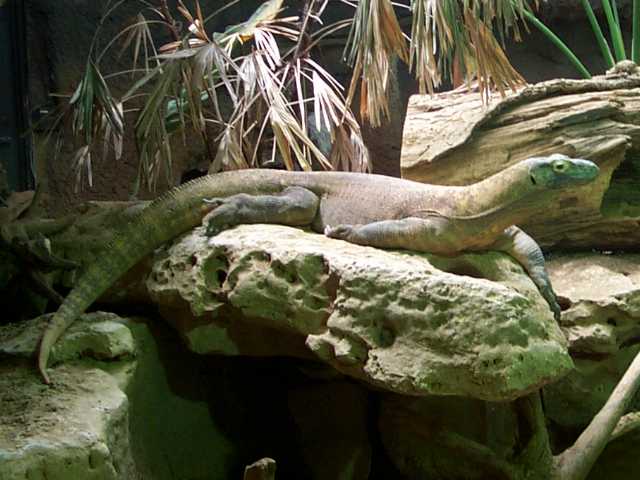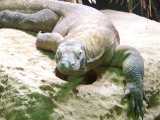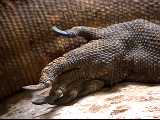HOME
ANIMALS
REPTILES
Komodo Dragon
Monitor
Lizard, or goanna, is the common name for a genus of lizards that
includes the largest living lizard, the Komodo dragon. Monitors live
in tropical and desert areas throughout Africa, in Asia from Arabia
through southern China and Malaysia, and in the East Indies and
Australia. There are about 30 species in the genus, ranging from 8
inches to 10 feet long. They are characterized by a long, forked,
snakelike tongue, and are able to engulf and swallow large prey
whole. They are sleek, fast runners with tapered heads, long necks,
strong legs, and long, powerful tails. Monitors feed on insects,
birds, reptiles and their eggs, small mammals, and carrion. Two
species, the Komodo dragon and the Gray's monitor, are listed on the
World Conservation Union Red List of Threatened Species.
 Monitors
are among the oldest living lizards. They are related to the
mosasaur, a marine lizard that lived from 136 million to 65 million
years ago and ranged up to 33 feet long. The largest monitor is the
Komodo dragon. Among the thousands of small islands of Indonesia is
one called Komodo. It is a mountainous stretch of volcanic rock
covered with grass, palms, and small pockets of jungle. This little
island, 22 miles (35 km) long, along with a few others nearby, is the
sole habitat of the world's largest lizard. The people of Komodo call
this animal "ora." Elsewhere it is known as the Komodo
Island monitor or more popularly, the Komodo dragon. Oras and other
monitor lizards are closely related to snakes.
Monitors
are among the oldest living lizards. They are related to the
mosasaur, a marine lizard that lived from 136 million to 65 million
years ago and ranged up to 33 feet long. The largest monitor is the
Komodo dragon. Among the thousands of small islands of Indonesia is
one called Komodo. It is a mountainous stretch of volcanic rock
covered with grass, palms, and small pockets of jungle. This little
island, 22 miles (35 km) long, along with a few others nearby, is the
sole habitat of the world's largest lizard. The people of Komodo call
this animal "ora." Elsewhere it is known as the Komodo
Island monitor or more popularly, the Komodo dragon. Oras and other
monitor lizards are closely related to snakes.
Oras
can reach 10 feet in length and weigh 300 pounds or more,
particularly after a meal. They are the top predators in their
habitat, feeding on wild boar, deer, water buffalo, dogs, goats,
rats, snakes, birds, other oras, and, once in a great while, humans.
They hunt by ambush, hiding in the scrub brush along trails and in
the tall grass of the savannas. Despite their lumbering appearance,
oras can move with alarming speed when they want to, lunging from
their hiding places and sprinting toward their startled victims. They
can't sustain a long chase, but often all they need to subdue their
prey is one bite. Oras carry poisonous bacteria in their mouths so
even if they don't immediately catch their prey, the attack is often
fatal. Using their long forked tongues, they track the scent of their
prey as the wounded animal slowly weakens from the infected bite, a
process that can take several days. When the victim can no longer
flee, the ora moves in for the kill. Oras are voracious eaters. They
devour every bit of their prey; bones, fur and hooves, ripping off
huge chunks with their razor-sharp serrated teeth and swallowing the
pieces whole. Like all predators, oras serve an important ecological
function: they preserve ecological stability by ensuring that prey
species (deer, for example) don't overpopulate and degrade their
island habitat. Although monitors are mainly terrestrial, some
species also climb trees and are good swimmers. The large water
monitor of East India can swim far from land.
 Oras
are reptiles. They don't need to eat as often as big mammalian
predators, such as tigers. As a result, the small island of Komodo
can support quite a few of these giant monitor lizards. Their total
population on the island is estimated at about 4,000 to 5,000 animals
and another 1,000 live on the neighboring island of Rinca. This same
amount of territory could only support a few dozen tigers. Still,
these numbers don't tell the whole story. The ora population includes
only about 350 breeding females. And as human populations grow, the
ora's limited habitat shrinks. On some islands, the coexistence
between people and giant lizards is an increasingly uneasy one.
Komodo Island is now a popular ecotourist attraction. The Indonesian
government is attempting to regulate this traffic so that disruption
of the oras is kept to a minimum. They can live up to 100 years.
Oras
are reptiles. They don't need to eat as often as big mammalian
predators, such as tigers. As a result, the small island of Komodo
can support quite a few of these giant monitor lizards. Their total
population on the island is estimated at about 4,000 to 5,000 animals
and another 1,000 live on the neighboring island of Rinca. This same
amount of territory could only support a few dozen tigers. Still,
these numbers don't tell the whole story. The ora population includes
only about 350 breeding females. And as human populations grow, the
ora's limited habitat shrinks. On some islands, the coexistence
between people and giant lizards is an increasingly uneasy one.
Komodo Island is now a popular ecotourist attraction. The Indonesian
government is attempting to regulate this traffic so that disruption
of the oras is kept to a minimum. They can live up to 100 years.
 Oras
caught in the wild don't survive well in captivity. They don't
reproduce readily, and often die from infections and parasitic
diseases. But some hatchlings born in zoos (including one born in
1992 at the National Zoo in Washington, DC) have done well. Young
oras live in trees, feeding on insects, until they're about a year
old and three feet long. Then they move permanently to the ground.
This strategy helps preserve the species; small oras on the ground
are sometimes preyed on by adults. The ora's yellow tongue and
repulsive mouth odor may have been the inspiration for legends of
fire-breathing dragons. Legal protection of oras has reduced
commercial hunting, but they are sometimes poisoned by villagers to
protect children and domestic animals.
Oras
caught in the wild don't survive well in captivity. They don't
reproduce readily, and often die from infections and parasitic
diseases. But some hatchlings born in zoos (including one born in
1992 at the National Zoo in Washington, DC) have done well. Young
oras live in trees, feeding on insects, until they're about a year
old and three feet long. Then they move permanently to the ground.
This strategy helps preserve the species; small oras on the ground
are sometimes preyed on by adults. The ora's yellow tongue and
repulsive mouth odor may have been the inspiration for legends of
fire-breathing dragons. Legal protection of oras has reduced
commercial hunting, but they are sometimes poisoned by villagers to
protect children and domestic animals.
In
1926, W. Douglas Burden, a trustee of the American Museum of Natural
History, organized an expedition to Komodo to capture oras and bring
them back to the U.S. It was he who first called them
"dragons." Burden came back with two living lizards and
some preserved specimens for study at the Museum. The live ones
survived for only a short time at the Bronx Zoo. In the Hall of
Reptiles on the third floor of the Museum, you can see some of the
preserved specimens Burden brought back.
Komodo
Island National Park is a national park in south central Indonesia,
occupying most of the island of Komodo, which lies in the Malay
Archipelago, east of the island of Sumbawa and west of the island of
Flores. First protected in 1938 and founded as a national park in
1980, Komodo Island National Park covers 520 sq km (200 sq mi). The
island has just one village of about 450 people. The island's
volcanic slopes are generally hot and barren, though briefly during
the annual monsoon season they turn green. A few tall lontar palm
trees grow on the hill slopes, and tamarind trees (tropical
evergreens) are found around the village.
The
island of Komodo is one of the few remaining areas inhabited by the
Komodo dragon, which is protected in Indonesia. Komodo dragons are
giant monitor lizards that roam wild over the island. Park officials
regularly supply pig and goat carcasses to attract the lizards to
viewing areas for tourists. Scientific classification: Monitors make
up the genus Varanus and the family Varanidae. The Komodo dragon is
classified as Varanus komodoensis, the water monitor as Varanus
salvator, and the Gray's monitor as Varanus olivaceus.
Microsoft
® Encarta ® Encyclopedia 2002. © 1993-2001 Microsoft
Corporation. All rights reserved.
http://animaldiversity.ummz.umich.edu/accounts/varanus/v._komodoensis$narrative.html
http://www.amnh.org/nationalcenter/Endangered/ora/ora.html
 Monitors
are among the oldest living lizards. They are related to the
mosasaur, a marine lizard that lived from 136 million to 65 million
years ago and ranged up to 33 feet long. The largest monitor is the
Komodo dragon. Among the thousands of small islands of Indonesia is
one called Komodo. It is a mountainous stretch of volcanic rock
covered with grass, palms, and small pockets of jungle. This little
island, 22 miles (35 km) long, along with a few others nearby, is the
sole habitat of the world's largest lizard. The people of Komodo call
this animal "ora." Elsewhere it is known as the Komodo
Island monitor or more popularly, the Komodo dragon. Oras and other
monitor lizards are closely related to snakes.
Monitors
are among the oldest living lizards. They are related to the
mosasaur, a marine lizard that lived from 136 million to 65 million
years ago and ranged up to 33 feet long. The largest monitor is the
Komodo dragon. Among the thousands of small islands of Indonesia is
one called Komodo. It is a mountainous stretch of volcanic rock
covered with grass, palms, and small pockets of jungle. This little
island, 22 miles (35 km) long, along with a few others nearby, is the
sole habitat of the world's largest lizard. The people of Komodo call
this animal "ora." Elsewhere it is known as the Komodo
Island monitor or more popularly, the Komodo dragon. Oras and other
monitor lizards are closely related to snakes. Oras
are reptiles. They don't need to eat as often as big mammalian
predators, such as tigers. As a result, the small island of Komodo
can support quite a few of these giant monitor lizards. Their total
population on the island is estimated at about 4,000 to 5,000 animals
and another 1,000 live on the neighboring island of Rinca. This same
amount of territory could only support a few dozen tigers. Still,
these numbers don't tell the whole story. The ora population includes
only about 350 breeding females. And as human populations grow, the
ora's limited habitat shrinks. On some islands, the coexistence
between people and giant lizards is an increasingly uneasy one.
Komodo Island is now a popular ecotourist attraction. The Indonesian
government is attempting to regulate this traffic so that disruption
of the oras is kept to a minimum. They can live up to 100 years.
Oras
are reptiles. They don't need to eat as often as big mammalian
predators, such as tigers. As a result, the small island of Komodo
can support quite a few of these giant monitor lizards. Their total
population on the island is estimated at about 4,000 to 5,000 animals
and another 1,000 live on the neighboring island of Rinca. This same
amount of territory could only support a few dozen tigers. Still,
these numbers don't tell the whole story. The ora population includes
only about 350 breeding females. And as human populations grow, the
ora's limited habitat shrinks. On some islands, the coexistence
between people and giant lizards is an increasingly uneasy one.
Komodo Island is now a popular ecotourist attraction. The Indonesian
government is attempting to regulate this traffic so that disruption
of the oras is kept to a minimum. They can live up to 100 years.  Oras
caught in the wild don't survive well in captivity. They don't
reproduce readily, and often die from infections and parasitic
diseases. But some hatchlings born in zoos (including one born in
1992 at the National Zoo in Washington, DC) have done well. Young
oras live in trees, feeding on insects, until they're about a year
old and three feet long. Then they move permanently to the ground.
This strategy helps preserve the species; small oras on the ground
are sometimes preyed on by adults. The ora's yellow tongue and
repulsive mouth odor may have been the inspiration for legends of
fire-breathing dragons. Legal protection of oras has reduced
commercial hunting, but they are sometimes poisoned by villagers to
protect children and domestic animals.
Oras
caught in the wild don't survive well in captivity. They don't
reproduce readily, and often die from infections and parasitic
diseases. But some hatchlings born in zoos (including one born in
1992 at the National Zoo in Washington, DC) have done well. Young
oras live in trees, feeding on insects, until they're about a year
old and three feet long. Then they move permanently to the ground.
This strategy helps preserve the species; small oras on the ground
are sometimes preyed on by adults. The ora's yellow tongue and
repulsive mouth odor may have been the inspiration for legends of
fire-breathing dragons. Legal protection of oras has reduced
commercial hunting, but they are sometimes poisoned by villagers to
protect children and domestic animals.